Exploring the Rich Tapestry: How Pichwai Artwork Captures the Essence of Festive Colors in Every Stroke
Introduction to Pichwai Artwork
Pichwai art, a traditional Indian art form, has long captivated the hearts of art lovers with its intricate details, spiritual themes, and, most notably, its vibrant celebration of colors. Originating over 400 years ago in the temple town of Nathdwara in Rajasthan, Pichwai paintings were initially created to adorn the walls of temples, serving as backdrops for the deity Shrinathji. These artworks not only depict tales from Lord Krishna’s life but also brilliantly capture the essence of festivals celebrated in His honor. Today, Pichwai artwork continues to enchant with its blend of mythological narrative and exquisite craftsmanship.
For those looking to explore or acquire pieces of this vibrant art form, Beyond Square stands out as the best place. Offering a curated collection that bridges traditional craftsmanship with contemporary aesthetic sensibilities, Beyond Square provides art enthusiasts with authentic and high-quality Pichwai paintings that bring the festive colors and divine joy of this art form to life.
The Essence of Festive Colors in Pichwai
Diving into the vibrant world of Pichwai artwork reveals a canvas where each stroke and hue whispers tales of devotion, tradition, and jubilant celebration. This traditional art form, originating from the heart of Rajasthan, India, serves not just as a visual delight but as a narrative medium, with colors playing the lead role. Pichwai paintings, renowned for their detailed depiction of Lord Krishna’s life and the festivities surrounding his worship, are a riot of colors that speak directly to the soul.
The festive colors used in these artworks are far from being just decorative elements; they are, in essence, the very heartbeat of Pichwai art, masterfully wielded to evoke a spectrum of emotions and mirror the rich, cultural tapestry of Indian festivities.
At the core of Pichwai artwork, the adept use of color is not only about aesthetic appeal but also about storytelling. Each color chosen by the artist serves a purpose, narrating different aspects of Lord Krishna’s life and the myriad of festivals celebrated in his honor.
These include the vibrant celebrations of Annakuth, marking a bountiful harvest, where the artwork is suffused with golden hues representing the heaps of grains offered to Krishna. Sharad Purnima, another festival lavishly celebrated, is depicted through soft, luminescent whites and blues, echoing the moonlit night when Krishna is believed to have performed the divine dance, Raas Leela. Gopashtami, celebrating Krishna’s association with cows, sees the judicious use of earthy tones and greens, reflecting the pastoral scenes of Vrindavan.
The colors in Pichwai paintings do more than just fill space; they breathe life into the canvas, transforming it into a living, breathing entity that celebrates the eternal dance of divinity with nature. The brilliance of a Pichwai artwork lies in how it uses colors to make the viewer feel part of the celebration, whether it be the joyous abandon of Holi, represented by a splash of myriad colors, or the serene divinity of Janmashtami, portrayed through deep blues and serene whites. Each festival, each celebration depicted in Pichwai art, is a testimony to the artist’s ability to harness the power of colors to convey a deeper sense of spirituality and festivity.
This masterful use of festive colors in Pichwai not only showcases the artist’s skill but also reflects a profound understanding of the cultural and spiritual nuances of the festivals depicted. It’s a visual journey through the seasons of festivity that mark the Indian calendar, offering a glimpse into the celebrations that punctuate the life of Krishna and, by extension, the life of the community that continues to venerate him through this exquisite art form.
Through the vibrant palette of Pichwai paintings, the colors of India’s rich festival culture come alive, inviting viewers into a world where art and devotion seamlessly merge, creating a tapestry of vivid, living tradition that continues to inspire and enchant.
Pichwai Artwork in Modern Spaces
The timeless allure of Pichwai artwork, with its deep spiritual roots and vibrant festivity, finds a resonant echo in contemporary spaces, bridging the gap between the traditional and the modern. As this ancient art form meets modern sensibilities, it not only enriches the aesthetic of contemporary interiors but also introduces a piece of Indian heritage to the global art scene.
This section delves into the adaptation of Pichwai art in contemporary interior design, its influence on modern art and culture, and how new artists are revitalizing this tradition with their innovative interpretations.
The Adaptation of Pichwai Art in Contemporary Interior Design
In the realm of interior design, Pichwai artwork emerges as a compelling focal point, infusing spaces with depth, color, and narrative. Designers and homeowners alike are drawn to Pichwai for its intricate details and vibrant depiction of festivity, making it a popular choice for those looking to add a touch of elegance and spirituality to their interiors.
Whether it’s a statement piece gracing the walls of a minimalist living room or a series of prints adding warmth to a modern office, Pichwai art adapts effortlessly, proving that ancient art can thrive in modern settings. Its rich palette and intricate compositions offer a visual feast, transforming any space into a place of contemplation and beauty.
Examples of Pichwai Influencing Modern Art and Culture
Pichwai’s influence extends beyond interior design, seeping into various facets of modern art and culture. Fashion designers have incorporated Pichwai motifs into their collections, translating traditional tales onto fabrics with a contemporary twist. Similarly, graphic designers and illustrators draw inspiration from Pichwai’s rich imagery, crafting visuals that marry the old with the new for digital platforms, branding, and even animation. This cross-pollination of ideas showcases the versatility of Pichwai motifs and their enduring relevance in today’s artistic landscape.
How New Artists Are Keeping the Tradition Alive While Adding Their Modern Twist
The resurgence of interest in Pichwai artwork has inspired a new generation of artists, who honor the tradition while steering it in exciting new directions. These artists, while deeply respectful of Pichwai’s historical and religious significance, experiment with scale, colors, and mediums to appeal to a contemporary audience. By blending traditional techniques with modern themes, they ensure the art form’s survival and relevance. Through their innovative works, Pichwai is seen not just as a relic of the past but as a living, evolving tradition that resonates with the global viewer.
For those intrigued by the modern interpretations of Pichwai or looking to explore a collection that perfectly encapsulates the blend of traditional craftsmanship with contemporary aesthetics, Beyond Square emerges as the premier online destination. Offering a meticulously curated selection of modern Pichwai paintings, Beyond Square is the go-to platform for art enthusiasts eager to dive into the world of Pichwai. Each piece in their collection is a testament to the timeless beauty of Pichwai art, promising not just a decorative element but a profound cultural and spiritual experience for modern spaces.
Incorporating Pichwai artwork into modern environments goes beyond aesthetic enhancement; it’s about creating a dialogue between the past and the present, the sacred and the secular. As we continue to navigate the waters of contemporary design, the essence of Pichwai — with its deep spiritual undertones and vibrant celebration of life — remains a beacon of inspiration, bridging worlds with its universal appeal. Beyond Square stands at the forefront of this cultural exchange, offering aficionados and novices alike a gateway to the rich tapestry of Pichwai art, reimagined for the modern era.
The Symbolic Meaning Behind the Use of Colors
In Pichwai artwork, every color holds a significance that goes beyond aesthetic appeal, deeply rooted in symbolism and tradition. The color blue, reminiscent of the serene skies and deep waters, is prominently used to depict Lord Krishna, symbolizing divinity and the infinite. The vibrant reds and saffrons are often seen in the attire of the figures and the flora, representing purity, passion, and religious fervor.
Meanwhile, the lush greens mirror the eternal nature of Vrindavan’s pastures, where Lord Krishna’s tales unfold. These colors are not randomly chosen but are a deliberate selection that adds layers of meaning to each artwork.
How Colors Are Chosen and Mixed in Traditional Pichwai Paintings
The artisans behind Pichwai artwork are meticulous in their approach to color selection and mixing, ensuring that each hue accurately conveys the intended emotion and narrative. Traditional Pichwai paintings employ natural pigments derived from minerals, plants, and even precious stones, which are painstakingly ground and mixed by hand.
This labor-intensive process results in colors that are not only rich and deep but also imbued with a natural vibrancy that synthetic pigments cannot replicate. The preparation of these colors is a craft in itself, passed down through generations, preserving the authenticity and integrity of the art form.
The Impact of Color on the Emotional and Spiritual Experience of the Viewer
The festive colors of Pichwai artwork are instrumental in creating a spiritual ambiance that transcends the physical boundaries of the canvas. For the viewer, these colors are a visual celebration, evoking feelings of joy, devotion, and a deep connection to the divine. The bright hues invite the onlooker into a world where every day is a festival, celebrating the glory of Lord Krishna and the beauty of life itself. This emotional resonance is what sets Pichwai art apart, making it not just a feast for the eyes but a nourishment for the soul.
Beyond Square, renowned for its exquisite collection of Pichwai paintings, showcases this vibrant joy of festive colors in each piece. The artwork available at Beyond Square is a testament to the enduring legacy of Pichwai art, bridging the gap between traditional craftsmanship and contemporary appreciation. For those looking to immerse themselves in the world of Pichwai, or to bring a piece of this colorful tradition into their homes, Beyond Square offers an unparalleled selection, each painting echoing the festive spirit and cultural richness of India.
As we delve deeper into the nuances of Pichwai artwork and its celebration of festive colors, it becomes evident that this art form is more than just a visual experience. It is a journey through the colors of devotion, tradition, and joy, inviting us to explore the depths of our spirituality and cultural heritage. Through the masterful use of festive colors, Pichwai paintings continue to captivate and inspire, making them a cherished treasure for art enthusiasts around the world.
Conclusion
As we’ve explored the rich tapestry of Pichwai artwork, it’s clear that this art form is more than just a visual feast; it’s a deep dive into the cultural and spiritual heritage of India, brought to life through vibrant festive colors. The timeless appeal of Pichwai paintings, with their intricate details and profound storytelling, continues to captivate and inspire. For enthusiasts eager to delve into the world of Pichwai or to own a piece of this magnificent art, Beyond Square emerges as an unparalleled choice.
With its commitment to authenticity, quality, and the promotion of traditional art forms in a modern light, Beyond Square ensures that each piece of Pichwai artwork it offers is a gateway to experiencing the rich cultural tapestry of India. Whether for your home or as a gift, a Pichwai painting from Beyond Square is not just an acquisition; it’s an inheritance of culture, color, and spirituality.
FAQs
What is Pichwai artwork, and why is it significant?
Pichwai artwork is a traditional Indian art form originating from Nathdwara, Rajasthan, over 400 years ago. These detailed, cloth-based paintings are dedicated to depicting Lord Krishna (Shrinathji) and the festivals celebrated in His honor. Significant for its cultural and religious importance, Pichwai art serves as a medium to narrate the life and times of Lord Krishna, combining devotional themes with intricate craftsmanship and vibrant colors, making each piece a spiritual and visual journey.
How do the festive colors in Pichwai paintings enhance their visual appeal?
The festive colors in Pichwai paintings are not just visually striking; they’re imbued with deep symbolic meanings and emotions. Bright reds, deep blues, and lush greens bring the stories to life, enhancing the narrative’s emotional depth and spiritual resonance. These colors transform the paintings from mere visual artifacts into a celebration of life and spirituality, making them visually appealing and emotionally engaging.
Can modern artists practice Pichwai art, and how?
Yes, modern artists can and do engage in Pichwai art, keeping this traditional form alive while adding contemporary touches. By learning the techniques, understanding the symbolism, and respecting the art form’s cultural roots, modern artists can contribute to the evolution of Pichwai. Workshops, traditional masters, and institutions that focus on Indian art forms provide the necessary education and training for interested artists.
What are some tips for beginners wanting to start with Pichwai painting?
For beginners eager to explore Pichwai painting, here are some tips:
- Study the History: Understand the cultural and religious significance of Pichwai to appreciate its depth.
- Learn the Symbols: Familiarize yourself with the common symbols and motifs used in Pichwai art.
- Practice Drawing: Start with sketching the figures and scenes commonly depicted in Pichwai paintings.
- Experiment with Colors: Use natural pigments where possible, experimenting with mixing and applying them to capture the art form’s essence.
- Seek Guidance: Consider learning from a seasoned Pichwai artist or joining a workshop to gain insights into traditional techniques.
How can I incorporate Pichwai artwork into my home decor?
Incorporating Pichwai artwork into your home decor adds a touch of elegance and cultural richness. Consider the following:
- Feature Wall: Dedicate a wall to a large Pichwai painting as a stunning focal point in your living room or dining area.
- Gallery Wall: Create a gallery wall with several smaller Pichwai pieces, mixing in different sizes and themes.
- Decorative Accents: Use framed Pichwai prints as decorative accents on shelves, mantels, or in your entryway.
- Themed Room: Design a room around a Pichwai painting, using colors and motifs from the artwork to inspire the room’s decor.
Where can I see authentic Pichwai paintings?
Authentic Pichwai paintings can be viewed and purchased at specialized art galleries, cultural exhibitions, and traditional Indian art fairs. Beyond Square is renowned for offering a curated selection of authentic and high-quality Pichwai artwork, making it an ideal destination for those looking to explore or acquire pieces of this vibrant art form.



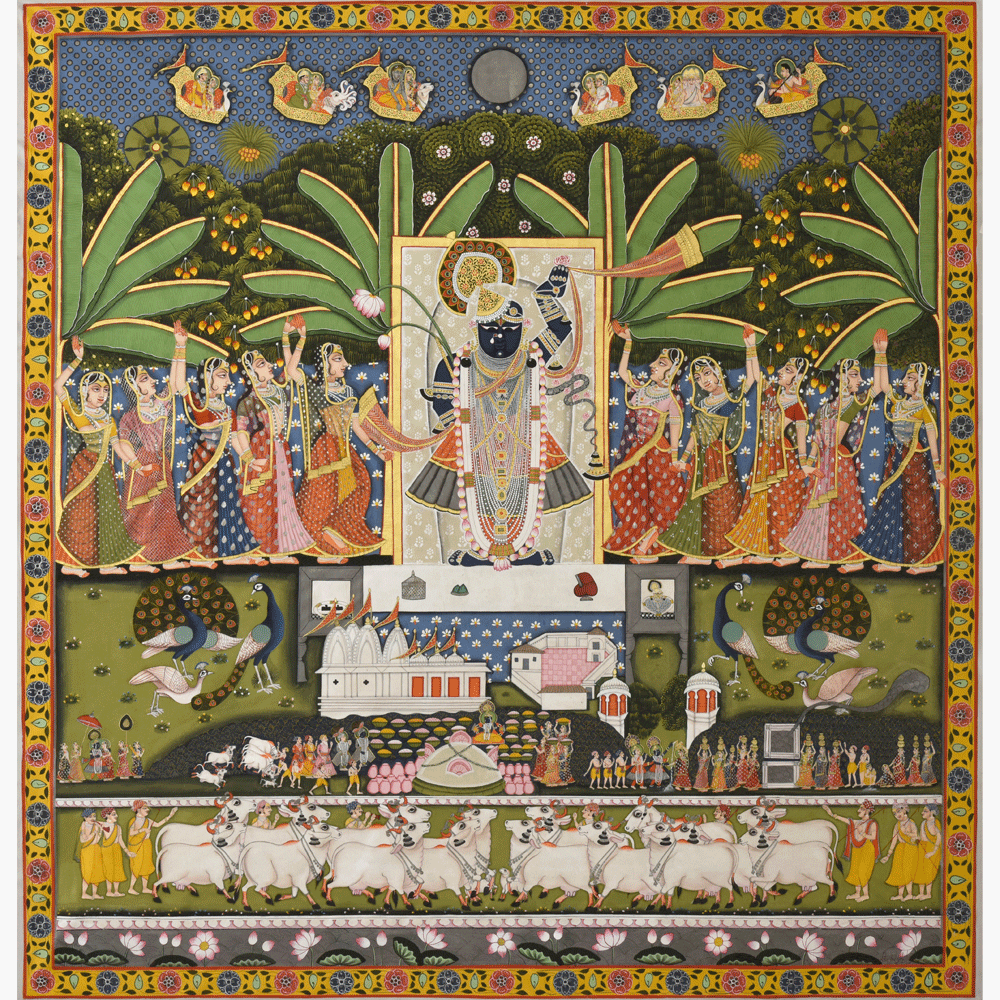
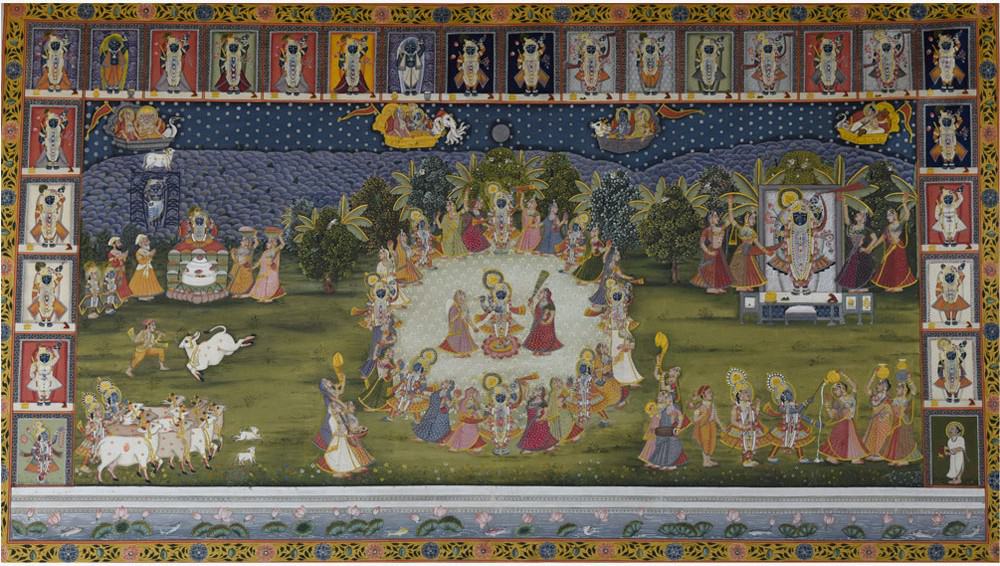
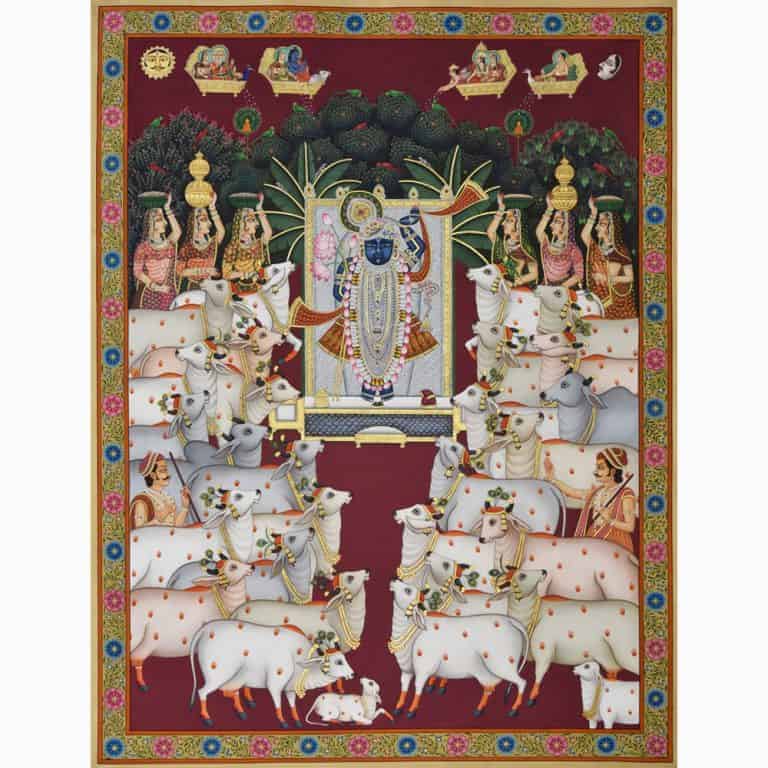
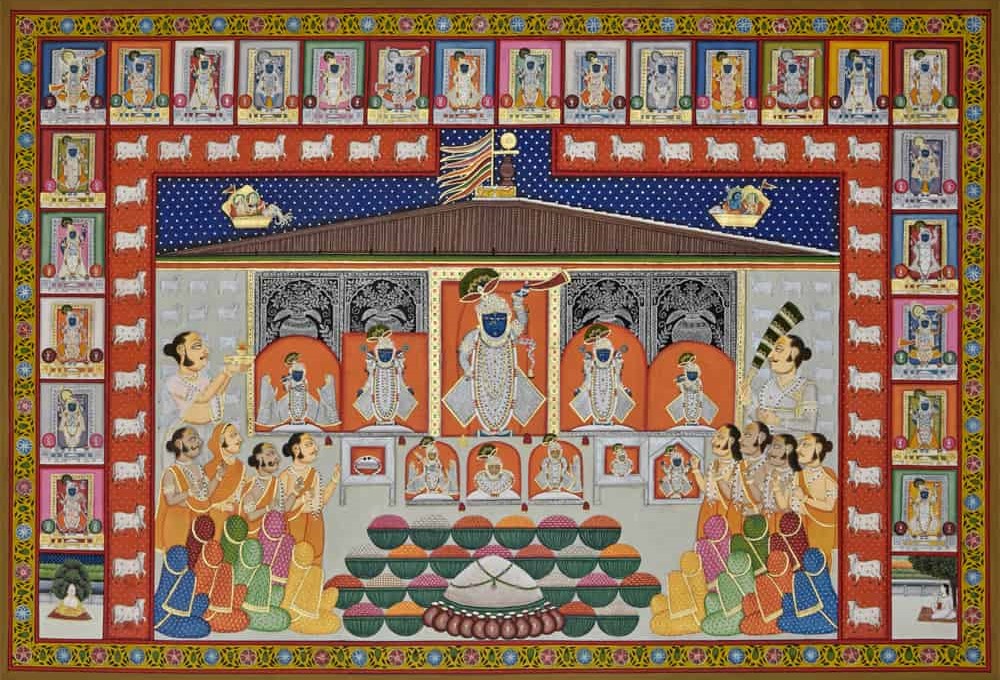
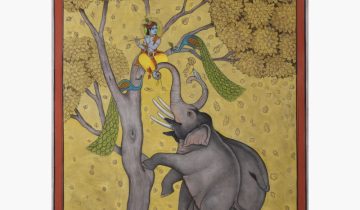
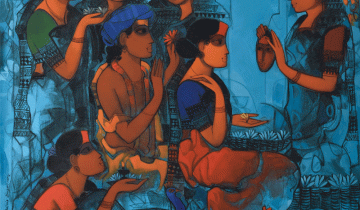
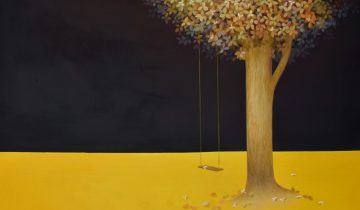
 No products in the cart.
No products in the cart. 